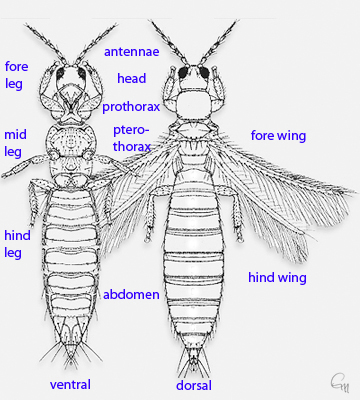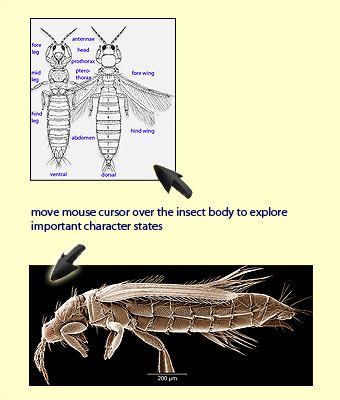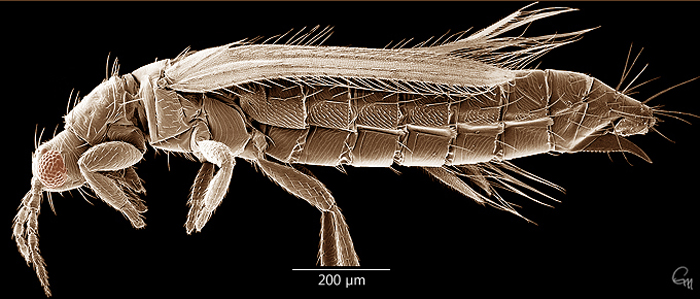ANTECOSTA
Anterior sclerite (pre- or acrotergite or pre- or acrosternite) of the antecostal ridge of a tergite or sternite.
ANTECOSTAL RIDGE
The groove that delimits the posterior base of the antecosta (= intersegmental groove). The submarginal thickening behind the anterior margin of each tergite and sternite is strongly sclerotised and works functional as origin for dorsal and ventral longitudinal muscle groups.
ANTEROANGULAR
Anterolateral corner of a sclerite (Latin, anterior = before, to the front of, angular = corner)
ANTEROMARGINAL
(Latin, anterior = before, or to the front of, margo = edge) narrow part of a surface within the edge, anteromarginal setae: setae inserted on the anterior margin of a sclerite.
APODEME
(Greek, apo = away, demas = body), Examples: apodem IX = a ridge process of tergite IX that forms a part of the insect endoskeleton and provides origin for the attachment of ovipositor muscles or tentorium with fore and hind tentorium arms and between a tentorium bridge (well developed in species of the family Aeolothripidae) and also providing origin for antennal and cibarial muscles).
BASANTRA
A pair of sclerites on each side of the anterior half of the ventral surface of the prothorax as subparts of the prosternum (well developed in species of the family Phlaeothripidae, =praepectal plates).
CAMPANIFORM SENSILLA
Sense organ that lacks an external process and displays the form of a simple circular pore or hollow cone in the cuticular surface (typical in thrips are the presence or absence of campaniform sensilla of the Mesonotum and the Metanotum craniale).
CILIA
Fringes or slender hair-like processes around the margins of the wings (Terebrantia: with 8-shaped socket cells, Tubulifera: without socket cells, fringes arise between the membrane layers of the wings.
character state
CLAVUS
Lobed area at the posterior base of the forewing.
CLYPEOFRONS
An unpaired ventrocranial head sclerite. The Clypeus consists of two parts: membraneous anteclypeus and the clypeus, which is fused with the frons, which is delimited by clypeus, inner margin of the compound eyes and cranial region of the vertex.
COMB
A row of closely spaced and slender microtrichia on the posterior margin of tergite VIII.
COMPOUND EYES
The compound eyes consist of an aggregation of a variable number of ommatidia.
COSTA
A thickened anterior longitudinal margin of the forewing.
COSTAL VEIN
Most anterior longitudinal vein of the forewing.
COSTAL CILIA
Cilia along the anterior margin of the forewing.
COXA
Basal segment of an insect leg.
CRASPEDUM
Thin sclerotized lobes on the posterior margin of abdominal tergites.
CROSS VEIN
Short veins, which connect the longitudinal veins.
CTENIDIA
Typical comb-like structures of very short microtrichia on the lateral discal area of tergites.
DISCAL SETAE
Small setae inserted in the middle area and not on the margin of a sclerite.
EPIMERON
Posterior division of the thoracic pleuron, separated from the Episternum by the pleural suture (in phlaeothripids often used for the separated posteroangular sclerite of the prothorax).
EPIMERAL SETAE
Setae which arise on the epimeral sclerites of the prothorax.
EPISTERNUM
Ventral plate of the prothoracic sternal region, caudolateral behind basantra and lateral to the spinosternum.
FEMUR
The 3rd part of an insect leg, following the coxa and trochanter.
FERNA
A pair of sclerites on the posterior half of the prosternum, just behind the basantra (=probasisternum).
FORE WING
Anterior pair of the wings, usually arising on the cranial edges of the mesosternum.
FRONS
Sclerite between anterior ocellus, lateral margins of the compound eyes and clypeus, which is fused to the clypeofrons.
FURCA
(=Endofurca): Part of the endosceleton of the meso- and metathorax (meso- and metafurca), the 2nd and 3rd segment of the thorax develope apodema from the ventral surface of their segment.
GENA
The cheek on each side of the head, lying beneath the compound eyes.
GLANDULAR AREA
Areas of cuticle with an iridescent, porous appearance that are assumed to have some secretory function.
HIND WING
Posterior pair of the wings, arising on the craniolateral edges of the metanotum craniale, tight to the fore wing base.
LABIUM
Bilaterally-symmetric and fused sclerites that form the "lower lip" or floor of the mouth cone.
LABIAL PALPS
Paired sensory appendages attached to the labium.
LABIUM
Ventral or hind part of the mouthcone, departed in prementum and postmentum.
LABRUM
An unpaired sclerite which forms the "upper lip" of the mouth cone.
MANDIBLE
Only the left mandible is developed in larvae and adult thrips. This is a blind stylet used to punch a hole in a leaf surface.
MARGINAL SETAE
Setae found at the margin of sclerites.
MAXILLARY BRIDGE
Endosceletal connection of the maxillary stylets deep in the head capsule of some phlaeothripid species.
MAXILLARY STYLETS
Paired needle-like structures, elongate part of the maxillae, developed from the laciniae.
MAXILLARY PALPS
Paired sensory appendages attached to the outer apical surface of the stipes (part of maxilla).
character state
MESONOTUM
Main dorsal sclerite plate of the 2nd segment of thorax.
MESOPRESTERNUM
Boat-shaped or laterally reduced triangular sclerites at the anterior margin of the mesosternum.
MESOSTERNUM
Main ventral sclerite plate of the 2nd segment of thorax.
METANOTUM
Main dorsal sclerite plate of the 3rd segment of thorax. craniale et caudale.
METASTERNUM
Main ventral sclerite plate of the 3rd segment of thorax.
METASCUTELLUM
Posterior sclerite plate of the 3rd segment of the thorax (= Metanotum caudale) behind the Metascutum (Metanotum craniale).
MICROTRICHIA
Rigid projections from the cuticle surface without any nerve supply.
MOUTH CONE
The united parts of labrum, labium, galea and stipes, which contain the stylets (laciniae and mandible).
OCELLAR SETAE
2 or 3 pairs of setae are commonly found on the head in the region of the ocelli; pair 1 if present is in front of the fore ocellus; pair 2 arise laterally near the inner margin of the compound eyes; pair 3 varies in position but is often near the anterolateral margins of the ocellar triangle.
OCELLAR TRIANGLE
Area on the dorsal surface (vertex) of the head of winged adults delimited by the 3 ocelli.
OCELLI
Simple eyes of adult winged thrips, typically three in a triangle on the vertex, with one anterior median and two lateral ocelli.
OVIPOSITOR
Ventral paired sclerite constructions of the VII and VIII abdominal segment for laying eggs.
PARAGLOSSA
A pair of lobes distolateral on the prementum, lying outside the glossae.
PEDICEL
The narrowed base of the 1st antennal segment of the flagellum (=3rd antennal segment).
PEDICELLUS
The second segment of the antenna, with intrinsic muscles, forming the pivot between scape and 3rd antennal segment.
PLEURITE
Lateral sclerite between tergite and sternite.
PLEUROTERGITE
Dorsolateral sclerite of the two lateral sclerites, closest to the tergite.
POSTEROANGULAR
(Latin, posterior = latter) behind the midline, caudal, angular = corner, for example: posteroangular setae = setae inserted on the posterior corners of a sclerite.
POSTEROMARGINAL
(Latin, posterior = latter) behind the midline, caudal, (Latin, margo = edge) narrow part of a surface within the edge, for example: posteromarginal setae = setae inserted on the posterior margin of a sclerite.
POSTMENTUM
Proximal part of the labium.
POSTOCCULAR SETAE
Setae arising just behind the compound eyes.
PREMENTUM
The distal end of the labium bearing labial palps, glossae and paraglossae.
PROBASISTERNUM
(=FERNA)
Pair of sclerites on the posterior half of the prosternum, in Phlaeothripids = Ferna, in Thripids previously referred to as probasisternum.
PRONOTUM
Dorsal region of the first thoracic segment.
SCAPUS
1st segment of the antenna.
SENSE CONE
A circular opening with a bifurcated or single conic process covered by a membrane.
SENSILLUM CAMPANIFORME
A belly formed sense organ that lacks an external process.
SENSORIUM
A circular, oval or band shaped opening covered by a membrane.
SETAE
Hair-like processes with a basal articulation.
SPINE (SPINULA)
Median process in some species on the anterior margin of the endofurca on the meso- or/and metathorax.
SPINASTERNUM
An intersegmental sclerite of the thoracic sterna bearing a spina.
STERNITE
Ventral sclerite of the abdomen.
TARSUS
The leg segment distal to the tibia, comprising 1 or 2 tarsomer segments, apically bearing the pretarsal bladder.
TENTORIUM
Internal sceleton of the head, which consists of a tentorium bridge, fore and hind tentorium arms. The anterior tentorial pits are visible below the ventral margin of the compound eyes.
TERGITE
Dorsal sclerite of an abdominal segment.
TESTES
2 containers produce spermatozoa within tubular follicles.
TIBIA
Leg segment between femur and tarsus.
TRICHOBOTHRIUM
Trichobothria consist of an elongate setae, which arise from a broad and deep cup. Trichobothria occur pairwise on tergite X in species of the families Merothripidae, Melanthripidae and Aeolothripidae.
VALVE
Gonapophysis, forming one of two paired blad- and saw-like structures supporting the oviposition procedure.
VEIN
Terebrantia have 3 longitudinal veins in the forewings, the costa along the front margin, and the first and second vein.
VERTEX
Top of the head between compound eyes, frons and occiput.
WING RETAINING SETAE
S-shaped setae on the tergites mainly of Phlaeothripidae. These setae enmesh with the marginal cilia on the wings when the wings are not in use. |



